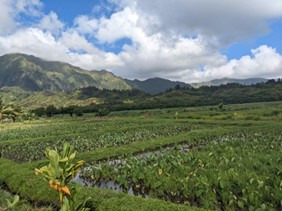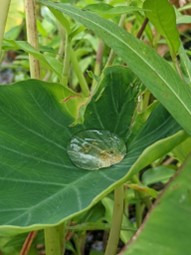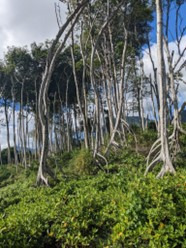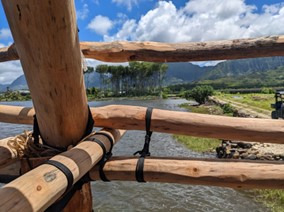Re-learning Food, Community, and Care on Windward O'Ahu
Somewhere along the way, I forgot there were so many different kinds of mud. This thought burst out of me with a chuckle as I placed one foot atop the muddy surface of a walkway between lines of kalo and sank with surprising speed up to my waist. So why was I in a patch full of kalo?
I am a third year PhD student in sociocultural anthropology at the University of Arizona and I traveled to Hawaiʻi this summer to feel out a possible dissertation research project that explores the links between kānaka maoli food sovereignty, invasive mangrove tree removal, and community participation in land and sea conservation and food cultivation work on the windward side of Oʻahu. I investigated these links through participant observation as a volunteer supporting Indigenous organizations working to cultivate native Hawaiian species and food traditions for the long-term resilience and independence of Hawaiʻi. Through a combination of procrastination and the summary evaporation of housing options I ended up renting a series of short-term Air-bnbs in the very center of Honolulu’s tourist infrastructure, Waikiki, an extremely costly area even outside the typical winter high tourist season. The volunteer work that I intended to do was across the mountains on the windward side of the island, however, for two organizations: Paepae o He’eia and Kākoʻo ʻŌiwi. Both organizations work within the ahupuaʻa[1] of He’eia.
As you drive along Kamehameha Highway, look makai and you will see, along the edge of the bay, Paepae o He’eia, an organization founded to revitalize and manage the loko iʻa kuapā (walled coastal fishpond) at He’eia, and cultivate local knowledge and participation in Indigenous Hawaiian practices of fishing and fish cultivation. Mauka (mountainwards) you will see the wetlands and loʻi managed by Kākoʻo ʻŌiwi with the craggy green heights of the Ko’olau range rising up behind it. Kākoʻo ʻŌiwi is an organization committed to both restoring the native wetland plants of He’eia stream and also creating loʻi kalo that can be adopted by He’eia community members for simply a promise that the adopting family will care for the lo’i and that they will make the occasional donation of lau (leaves: pictured right) and roots of kalo to Kākoʻo so the organization staff can pound it into poi for a local food bank. To do my fieldwork, I would drive to and from the windward side of the island over the Ko’olau range every day, an endeavor that pressured my limited research budget with fuel prices high over the summer. Each morning I drove from an experience deeply saturated in the curated ideas of tourist adventure in Hawaiʻi flush with bright billboards, tropical vacation imagery, and swanky hotels to windward O’ahu’s loʻi, wetlands, smaller coastal cities, and coastlines. While my work was not necessarily outside the tourist experience, it did support different kinds of indigenous food production rooted in community-centered experiences of food, cultivation, and flourishing, and shape my own understanding of these elements in the process.
It was this work that landed me in the mud of a loʻi kalo on a Tuesday morning. I had signed up as a wetland management volunteer and arrived to find an empty parking lot. Seeing my lost and confused expression and taking pity on me, one of the workers at Kākoʻo pulled by on a gator and then drove me to the other side of the property where other workers were overseeing a small group of volunteers in weeding a kalo patch. As the senior worker directing us indicated, young kalo huli need plenty of dynamic water flow to grow strong, and so turning a kalo patch choked with weeds into a series of clean straight rows interspersed by unimpeded flows of water is critical (pictured left).

If you’ve ever weeded a garden, there’s a physical quality to the soil that always made it easy, at least for me, to casually pull

weeds. Weeding a kalo patch and planting kalo huli required a higher level of care and intimate connection. Often the weeds tangle around the kalo and separating them while keeping the kalo situated in its position required cupping the huli and gently untangling any weeds and shaking out any mud from the weeds before pulling them out to leave the nourishing black mud and huli in place. As I learned from volunteering in loʻi and from those who taught me there, kalo is more than a crop or garden plant. Of kalo and its connection to Hawaiian health, Juliet McMullin says the following in The Healthy Ancestor: Embodied Inequality and the Revitalization of Native Hawaiʻian Health: “Native Hawaiian health involves more than merely attending to the physical body; it is intimately tied to a communion with ancestors (Kupuna), with the land and kalo that they care for and that in turn cares for them. These symbolic relationships reflect a tethering of people to the land through their caring for, consumption of, and ultimate return to it.”
On the other side of the road, my volunteer work for Paepae o Heʻeia took a different form. Getting to know and work with a group of Kanaka Maoli college and high school students, I helped the essential but slow work of clearing generations-old mangrove trees and also moved old coral to be used to set the foundation for a new hale, one of many different kinds of structures along the stone line of the fishpond’s kuapā used for various activities around managing the fishpond. Mangrove trees, especially some of the ones rooted along the edges of He’eia fishpond, are tough but essential to remove. Tough for me not only because mangroves of multiple generations of age are both deeply rooted and enormous, but also because as someone who grew up among the mangroves of South Florida, where they are native, uprooting trees I had been taught to cultivate and value, was dissonant and difficult. Essential though, because not only do invasive mangroves also provide essential habitat for invasive fish species that crowd out native Hawaiian fish, but they also accumulate vast amounts of sediment that fundamentally change the water quality and hydrology of the fishpond. Thus, removing them is essential for creating the conditions for the flourishing of native fish and plant species and indigenous Hawaiian foodways and food sovereignty.
Planted on Molokaʻi in 1902 by the American Sugar Company, and then introduced again as seeds in the ballast tanks of American naval vessels during World War II, the proliferation of

mangroves (pictured left) as invasives is intimately tied in with ongoing military and settler colonialism in Hawai’i, systems apparent in the ways in which military bases and state scientific institutions exercise control and ownership over lands, waters, and ecologies to the exclusion of Hawaiians themselves. The spread of invasives, plants and animals both, is one among many ongoing impacts of colonialism on Hawai’i and its people. Some of those invasives choke the very waterways Kākoʻo ʻŌiwi’s farmers, wetland technicians, and volunteers work so hard to clear, in order to cultivate kalo as their kūpuna did. Therefore, supporting various forms of management and removal provides one way of working towards the flourishing of Indigenous Hawaiian life and food in multiple ways.
At the end of my first day of weeks volunteering at Kākoʻo ʻŌiwi, I asked uncertainly if it was okay if I came back to weed as a volunteer again and when. Mahea told me that I was welcome to come as much as I wanted, as long as I signed up. She told me that the work I did needed to be done every single day. This highlights the enormity of the task ahead for those who would work to cultivate and regenerate Indigenous Hawaiian food practices but it’s also a demonstration of the strength of their hands, hearts, and the depth of their commitment to forge community connections to this work.
One of the last days that I volunteered at He’eia fishpond this summer, the supervisor of interns, volunteers, and fishpond restoration who led our work at Paepae o Heʻeia told a group of volunteers and interns the history of the building of the kuapā. He described the chains of thousands of people who moved rocks hand to hand out to the bay to fit together the wall, the roots of the daily practice we used to hand off materials to build up the foundations of the hale or the mangrove lumber we used to build the structure itself (pictured right with mangrove stands in the background). As a friend presented it to me, “this work imbues each stone with community care and energy to form a structure built to continue to support and nurture them in return; a relationship of reciprocity.” Sharing in this work reminded me of a moment when, about halfway through my trip, a dear friend sent me the words of Hāwane Rios, a kānaka ʻōiwi singer, songwriter, and land protector. Among a range of thoughts directed to those who are not Hawaiian but would come to Hawai’i, she says of her native Hawai’i that “once you drink of our waters and eat of our food, you become accountable to Hawaiʻi.”

Hawaiʻi nourished my mind and body quite likely even before I knew that it did, and it certainly did while I stayed there during July of 2022. Many days, I ate many times my weight in laulau, lomi salmon, poi, and memorably devoured plates of taro pasta and luau, malunggay noodles, and lechon from the nearby Adela’s Country Eatery with fellow volunteers and interns from Kāneʻohe and all along windward Oʻahu. I continue to be accountable to Hawai’i. While I work to learn and broaden the ways in which I can repay Hawaii and its people, I am thankful for the lesson of one of the volunteer supervisors under which I worked this summer: come to the land with your hands held down and not up. When you come with hands up and outstretched, you’re asking to be given something, before anything else. When you come with your hands down, you come offering your own work; to give before you take. When I come back to Hawaiʻi, hopefully soon, I will come with hands down.
Bio: Skylar Benedict is an enthusiastic student of languages, aquatic plants, and blues music currently in his third year as doctoral student in the University for Arizona School of Anthropology. Pursuing studies in applied environmental anthropology, Skylar currently researches community conceptions of mangrove value and their relationship to estuary management and food cultivation in both Sonora, Mexico and O’ahu, Hawai’i. Skylar’s work blends participant observation and informal interviews to investigate how people in both communities articulate their relationships with mangroves and other forms of estuarine life. The CRFS research award helped to reduce the substantial cost of short-term housing on O’ahu for Skylar during the summer of 2022 to pursue this research.
To Contact: skylarbenedict@arizona.edu
[1] I continuously cite Nā Puke Wehewehe ʻŌlelo Hawaiʻi throughout this piece in an attempt to shift any authority in naming and Hawaiʻian words from myself to Hawaiʻian experts themselves.

